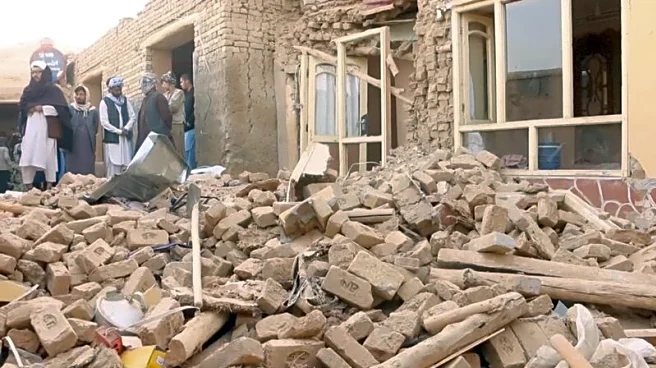What's Happening?
A powerful magnitude 6.3 earthquake struck northern Afghanistan near the city of Mazar-i-Sharif, resulting in at least 20 deaths and hundreds of injuries. The earthquake occurred early Monday morning at a depth of 28 kilometers, approximately 22 kilometers from
Kholm. The United States Geological Survey (USGS) issued an orange alert, indicating that significant casualties are likely and the disaster could be widespread. The Afghan Red Crescent has dispatched rescue and medical teams to the affected areas. The quake follows a series of significant seismic events in the region, including a 6.0-magnitude quake in August that killed over 2,200 people.
Why It's Important?
The earthquake highlights the vulnerability of Afghanistan to seismic activity, particularly in regions where the Eurasian and Indian tectonic plates meet. The frequent occurrence of earthquakes poses a continuous threat to the population, especially in areas with infrastructure built from mud bricks, which are highly susceptible to damage. The disaster exacerbates existing challenges in Afghanistan, including a severe drought and the return of millions of Afghans from neighboring countries. The international community may need to provide humanitarian aid and support to assist in recovery efforts and mitigate the impact on the affected population.
What's Next?
Rescue operations are underway, with local and international agencies likely to assess the full extent of the damage and coordinate relief efforts. The Afghan government and humanitarian organizations may call for international assistance to address the immediate needs of the affected communities. Long-term strategies may be required to improve infrastructure resilience and disaster preparedness in earthquake-prone regions.
Beyond the Headlines
The earthquake underscores the need for improved building standards and emergency response systems in Afghanistan. The country's ongoing political and economic instability complicates efforts to implement such measures. Additionally, the disaster may influence international perceptions of Afghanistan's capacity to manage natural disasters, potentially affecting foreign aid and investment.















